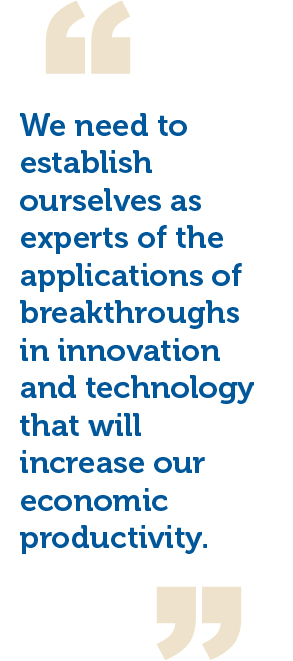

Digital Economy; the new driver of economic growth
Malaysia is currently mired in the middle-income trap, our GDP per capita has fallen to 9,944 nominal US dollars from a peak of 11,183 in 2014. Productivity growth has declined in recent decades after not fully recovering from the impact of the Asian Financial Crisis between 1997 and 1998 as well as being hard hit by the Global Recession that impacted the nation from 2007 to 2009. According to a World Bank report on Malaysia released in September, the country is at a crossroad. The economic model that successfully catapulted Malaysia to upper middle-income status will not sustain robust growth indefinitely.
Dato’ Seri Mohamed Azmin bin Ali, Minister of Economic Affairs, in his opening address at the Khazanah Megatrends Forum 2018 said that for Malaysia to break out of the middle-income trap, a different economic logic is required. Malaysia needs to shift towards new industries and to adapt to the global technology landscape.
“We need to establish ourselves as experts of the applications of breakthroughs in innovation and technology that will increase our economic productivity.”
According to the World Bank, similar ingredients that propelled the Electrical and Electronics revolution in Malaysia in the 1970s are in place for a similar transformation of the digital economy. When the Penang Free Trade Zone (FTZ) was set up in 1969, then Intel CEO, Andy Grove established Intel Malaysia in 1972 thus setting the stage to launch Malaysia as an Electrical and Electronics global manufacturing hub. Eventually, other big names in the microelectronics industry such as Advanced Micro Devices, HP, Hitachi Semiconductor amongst others established their presence at the FTZ, catapulting Malaysia up the value chain, integrating into regionally distributed production networks, increasing specialization while relaying simpler labour-intensive jobs to other countries.
 In 2016, Malaysia was the first country in the world to establish a Digital Free Trade Zone (DFTZ) to promote the growth of e-commerce by providing a state-of-the-art platform for small and medium enterprises. Jack Ma, CEO of the largest e-commerce company, Ali Baba has committed major investments to the DFTZ.
In 2016, Malaysia was the first country in the world to establish a Digital Free Trade Zone (DFTZ) to promote the growth of e-commerce by providing a state-of-the-art platform for small and medium enterprises. Jack Ma, CEO of the largest e-commerce company, Ali Baba has committed major investments to the DFTZ.
However, before Malaysia blossoms into the e-commerce hub of the region, a dynamic ecosystem for digital economy to flourish needs to be established aligning digital connectivity, digital entrepreneurship and the taxation of digital platforms. This embodies changes to infrastructure to ensure it is ubiquitous, fast and inexpensive as well as to fix regulation to curb unfair business practices.
To give the digital economy the boost that it requires to spur economic growth for the nation, Azmin has stressed that the role of government is especially important in the area of R & D such as the new development of new technology. In this regard he says, “Government support is invariably needed, particularly in the development of new technology with long gestation periods and high initial fixed costs that are typically too risky for pure private sector firms.” However, he said firms too need to move away from being too myopic on chasing short-term profits as this will reduce their long-term sustainability and profitability. To spur economic growth driven by the high-tech sector, Azmin says public and private collaboration is crucial as Malaysians are the most digitally connected citizenry in the world.
While the government is taking a balanced development path, to recalibrate policies to enhance inclusion, integrity and sustainability while delivering economic growth, the influx of foreign investments is greatly needed. According to Azmin, “long-term FDIs in greenfield investments is encouraged to create jobs, boost purchasing power and help create a better economic eco-system.”
The challenge Malaysia faces now amidst a backdrop of a trade war with the potential of escalating into a geopolitical dispute with military implications is navigating between strong fiscal discipline and stimulating economic growth. What is evident, as Azmin highlighted, because of such regional uncertainties, intra-regional trade must be enforced and ASEAN regarded as a defacto domestic market to enable growth, scale and opportunity.
In his closing address at the China Conference 2018, Azmin said that “China’s vibrant economic initiatives will be pivotal in contributing towards greater economic integration in ASEAN with emphasis on infrastructure development and advancements in technology and research.” Malaysia, he added, “has already embarked on the process of moving towards enhancement of e-commerce, digital economy and smart solutions in line with our move to deal with the challenges of the Fourth Industrial Revolution.”





